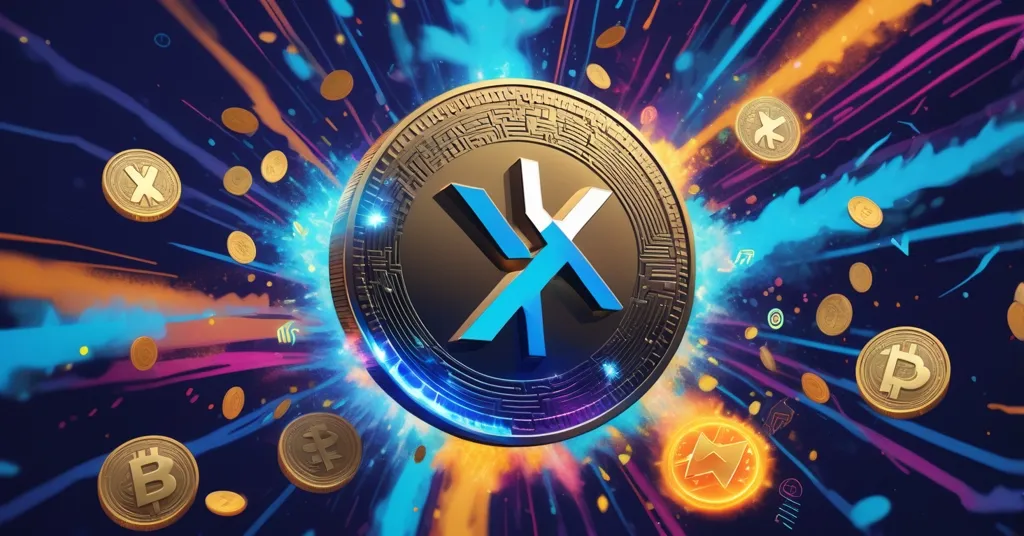Ripple (XRP) Eyes $7–$13 by 2025 as Pepeto Memecoin Hypes 10,000% Gains—Boom or Bust?

Ripple (XRP) Price Targets $7–$13 by 2025 as Pepeto Memecoin Sparks 10,000% Gain Hype—Reality or Mirage?
Ripple (XRP) is grabbing headlines with bullish forecasts pointing to $7–$13 within the next 25 months, while a newcomer, the Ethereum-based memecoin Pepeto (PEPETO), is stirring up frenzy with promises of a staggering 10,000% surge for early investors. Let’s slice through the hype, dissect the drivers behind these predictions, and weigh what’s plausible against what’s pure fantasy in this chaotic crypto frontier.
- XRP Outlook: Predictions of $7–$13 by 2025, backed by whale buying, technical signals, and regulatory breakthroughs.
- Pepeto Speculation: Presale at $0.000000146 with over $6M raised, teasing returns up to 20,000% amid memecoin mania.
- Risk vs. Reward: XRP offers a measured bet; Pepeto is a high-stakes gamble despite some utility hooks.
XRP’s Regulatory Rollercoaster: Bullish Momentum or False Dawn?
Hovering around $3.20 based on recent market data, Ripple’s XRP—a cryptocurrency tailored for cross-border payments via Ripple Labs—has emerged from a brutal legal slugfest with the U.S. Securities and Exchange Commission (SEC) with renewed vigor. A landmark ruling in July 2023 declared XRP not a security in secondary market transactions, a decision that’s ignited investor confidence and sparked what many call “post-SEC clarity.” This has coincided with noticeable whale accumulation—large investors snapping up significant chunks of XRP, often viewed as a bullish indicator of faith in its trajectory.
Technical analysts are jumping on the bandwagon with their charts and projections. Some highlight Elliott Wave patterns, a method that maps market psychology to predict price swings, pegging a near-term target of $7 by mid-to-late 2025. Reports of climbing spot trading volumes and heightened network usage (though specific figures remain elusive) suggest momentum could drive XRP to a base range of $6–$8 by August or September next year. More grounded estimates place it between $3.20 and $4.00 for now, while an optimistic bull case sees $5–$7 by late 2025. Then there’s the wild fringe—unnamed technicians floating a $14 target within a mere 40 days, a 333% leap that reeks of blind optimism. A longer-term peak of $13 isn’t entirely dismissed, but it hinges on sustained regulatory calm and corporate treasuries integrating XRP as a payment solution, a scenario far from certain in a space where macro shocks and policy U-turns lurk around every corner. For deeper insights, check out this detailed analysis on XRP price predictions for 2025.
Let’s be blunt: XRP isn’t Bitcoin. While it carves a niche in fast, low-cost transactions for banks and remittance firms—think partnerships like those with Santander or MoneyGram—its setup is starkly centralized. Ripple Labs holds a massive portion of the token supply and influences key validator nodes, a far cry from Bitcoin’s trustless, decentralized architecture where no single entity calls the shots. This centralization undermines the ethos of financial sovereignty that fuels the crypto rebellion. Sure, XRP’s utility in cross-border payments addresses a real-world pain point, but it’s up against fierce competition from decentralized finance (DeFi) protocols on Ethereum, stablecoins like USDT, and even Bitcoin’s Lightning Network, which offers scalable microtransactions without sacrificing user control. And while the SEC win is a middle finger to government overreach, regulatory sands can shift—new policies or administrations post-2024 could slap fresh hurdles on XRP’s path. Curious about its long-term potential? Explore what the future holds for XRP in payments.
Why XRP Might Stumble
Beyond regulatory flip-flops, XRP faces threats from emerging alternatives in the payment space. Central bank digital currencies (CBDCs)—government-backed digital money currently in development by over 100 countries—could muscle in on XRP’s territory, offering similar speed and cost benefits with state-sanctioned trust. If nations roll out CBDCs for cross-border transfers, why would banks bet on a crypto with baggage? Even within crypto, stablecoins tied to fiat value provide a less volatile option for transactions, potentially siphoning off XRP’s use case. Without deeper adoption data—RippleNet’s transaction volume growth post-SEC ruling remains vague—it’s hard to gauge if XRP’s momentum is real or just market froth. For a broader perspective, see this XRP price forecast analysis for 2025.
Pepeto (PEPETO): Memecoin Madness with a Utility Edge?
Switching gears to the wilder side of crypto, Pepeto (PEPETO) enters the ring as an Ethereum-based memecoin aiming to be more than just a fleeting internet gag. Priced at a minuscule $0.000000146 during its presale phase, this project—led by a former co-founder of the viral PEPE token—has already pulled in over $6 million from speculators hungry for the next big thing. With a staggering total supply of 420 trillion tokens, its tokenomics (the structure of supply and distribution affecting value) split as 30% for presale, 12.5% for liquidity pools, 20% for marketing and growth efforts, and 30% allocated to staking with post-token generation event (TGE) annual percentage yields (APY) targeting up to 255%.
What makes Pepeto stand out in a swamp of meme-driven fluff? It’s not purely banking on viral tweets or celebrity nods—though those inevitably play a role. Pepeto introduces tangible features like PepetoSwap, a zero-fee trading platform that uses smart contracts to let users swap tokens without extra costs, potentially doubling= doubling as a launchpad for other memecoins. It also boasts a native cross-chain bridge, enabling seamless token movement between different blockchains—a handy tool in a fragmented crypto landscape. Built on Ethereum’s mainnet rather than cheaper Layer-2 networks, Pepeto taps into Ethereum’s vast liquidity and developer community, though this means users face higher gas fees (transaction costs on Ethereum, akin to tolls on a busy highway). Dual audits by SolidProof and Coinsult validate its smart contracts—the underlying code—offering a veneer of security in a space notorious for exploits, though no audit guarantees immunity from hacks or scams. Learn more about its features in this overview of Pepeto’s presale and utility.
Now for the hype that’s got tongues wagging: speculators are throwing around potential returns of 1,000% (price to $0.000001606, market cap of $674.5 million), 10,000% ($0.000014746, $6.19 billion market cap), or an absurd 20,000% ($0.000029292, $12.38 billion market cap) for early buyers. A rumored Binance listing post-TGE is hyped as the golden ticket, but let’s not drink the Kool-Aid—there’s no official confirmation, and pinning hopes on it is like gambling your rent money on a hunch. Historical memecoin cycles, like PEPE and Dogecoin, show insane gains are possible—recent data pegs memecoins outperforming the broader crypto market by 6x over a 30-day span—but the carnage is real. Over 90% of these tokens implode within a year, often after early whales cash out, leaving latecomers with worthless bags. Pepeto’s massive 420 trillion supply also raises inflation risks; without aggressive burning mechanisms or demand, dilution could tank value faster than a rug pull. Dive into Reddit discussions on historical memecoin returns for a reality check on these massive surges.
Scammer Alert: The memecoin arena is a breeding ground for fraud—rug pulls, fake presales, and phishing sites are rampant. If you’re considering Pepeto, verify every link and wallet address through official channels on their website, not random social media DMs or shady Telegram groups. One misstep, and your funds could vanish quicker than a meme fades from relevance. Be cautious and check out community warnings on Pepeto memecoin hype and associated risks.
Why Pepeto Could Flop
Even with audits and utility, Pepeto’s long-term viability is a giant question mark. Memecoins thrive on hype, not fundamentals, and if PepetoSwap or the cross-chain bridge fail to gain traction—say, if users balk at Ethereum’s gas fees or prefer established platforms like Uniswap—the project could fizzle. Regulatory scrutiny on Ethereum-based tokens is another dark cloud; if authorities crack down on speculative assets, Pepeto’s meme status won’t shield it. And let’s not ignore history: Shiba Inu and Dogecoin soared on community fervor, but thousands of copycats crashed without a trace. Pepeto’s story is unwritten, and the odds aren’t exactly in its favor. For context on similar projects, explore the challenges and utility of Ethereum mainnet memecoins.
Balancing the Scales: XRP’s Grounded Growth vs. Pepeto’s High-Risk Bet
XRP and Pepeto sit at opposite ends of the crypto gamble. XRP offers a more calculated wager, leveraging regulatory progress and institutional interest, with a $7 target feeling within reach if market tailwinds hold. Its role in payments could accelerate blockchain adoption, aligning with our push for effective accelerationism (e/acc)—driving tech disruption at full throttle—but its centralized DNA limits its revolutionary punch. Pepeto, by contrast, is the adrenaline junkie’s play: explosive upside if catalysts like a Binance listing or PepetoSwap adoption ignite, but a near-certain wipeout if the hype train derails or scammers strike first. A diversified approach might blend XRP’s relative stability with a tiny splash of Pepeto’s speculative fire, but don’t be fooled—crypto isn’t a lottery ticket, no matter how many zeros these forecasts flash. For additional context, review this guide to XRP price predictions for the next 25 months.
Bitcoin’s Shadow: The True Standard of Freedom
Let’s zoom out to the bigger battle. Bitcoin remains the undisputed titan of decentralization, a defiant stand against centralized finance with its hard-capped 21 million supply and proof-of-work security ensuring no overlord can meddle. XRP’s corporate tilt and Pepeto’s meme-fueled chaos fill specific niches—payments and speculative fun, respectively—but neither touches Bitcoin’s core strengths: privacy, autonomy, and enduring value storage. Ethereum’s infrastructure, powering Pepeto, showcases blockchain’s versatility with smart contracts enabling complex apps, yet its scalability struggles and hefty gas fees underscore why Bitcoin’s laser focus on being digital gold still reigns supreme. As we advocate for disrupting the status quo, projects like XRP and Pepeto can push adoption in their own way, but true financial freedom lives on Bitcoin’s chain. Neither of these assets addresses the raw, unfiltered mission of BTC—to be a censorship-resistant fortress in a world of control.
Key Takeaways and Questions for Crypto Enthusiasts
- What’s powering XRP’s bullish forecasts for 2025?
Drivers include whale accumulation (big investors buying in bulk), technical signals like Elliott Wave patterns, increased network activity, and the 2023 SEC ruling that XRP isn’t a security in secondary trades, plus potential corporate uptake. - Are XRP price targets of $7 to $13 realistic?
Hitting $7 looks feasible with current market depth and momentum, but $13–$14 demands a prolonged bull market and smashing through resistance levels, a stretch without guaranteed conditions. - What sets Pepeto apart in the memecoin frenzy?
Pepeto offers more than hype with PepetoSwap for zero-fee trading, a cross-chain bridge for inter-blockchain transfers, and audited contracts on Ethereum mainnet, giving it a utility edge over typical meme tokens. - Is a 10,000% return on Pepeto even possible?
It’s within the realm of past memecoin surges if hype cycles repeat and events like a Binance listing spark demand, but it’s a speculative long shot tied to volatile sentiment and untested adoption. - What risks should be on investors’ radar?
XRP risks include regulatory backtracking and market slumps, while Pepeto’s memecoin volatility, scam vulnerabilities, and speculative nature make it a far dicier bet, even with security audits.



